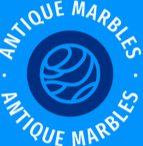Sulphide
Sulphides, cherished among collectors, are meticulously crafted German marbles featuring a central chalk-like figure, often depicting animals or occasionally human or inanimate subjects like numbers or coins. Typically, these figures rest atop faceted pontils, sometimes found beneath or at the rear of the figure. Instances of unfinished pontils, notably on smaller “Peewee” Sulphides, are occasionally observed.
Distinguished variations include “Donut Hole Sulphides,” featuring deliberate perforations, a rarity treasured by enthusiasts. Similarly, Sulphides boasting multiple figures—such as a woman accompanied by a dog—are uncommon finds.
Encasing more than one figure within a Sulphide marble is a rarity, as is the use of colored glass or painted figures, serving as distinctive hallmarks of authenticity. Caution is advised against modern reproductions, exemplified by the “California Sulphides” of the 1980s, often characterized by unique figures, colored glass, or peculiar pontil marks.
Distinguishing between contemporary and traditional German Sulphides is crucial. The former typically feature highly embellished figures and flawless, crystal-clear glass, often devoid of pontils and may bear the maker’s initials. Conversely, genuine antique Sulphides often fluoresce a faint yellow under black light, excluding most Peewee variants.
Sizing conventions range from 1-1/4″ to 1-3/4″ for standard Sulphides, with smaller Peewee variants measuring below 1″ and larger specimens exceeding 2″, albeit challenging to procure in mint condition due to susceptibility to damage. Many collectors opt for polished Sulphides, albeit at the risk of potential alterations.
